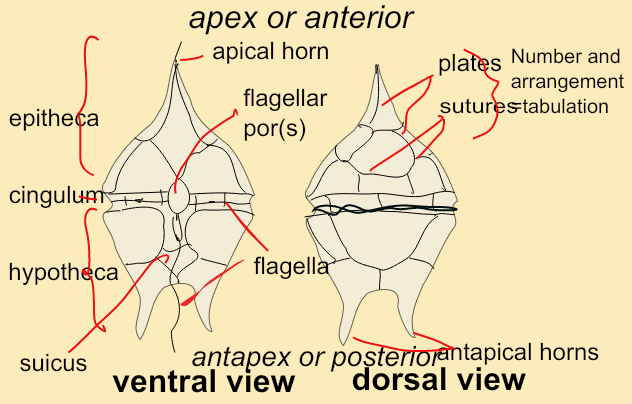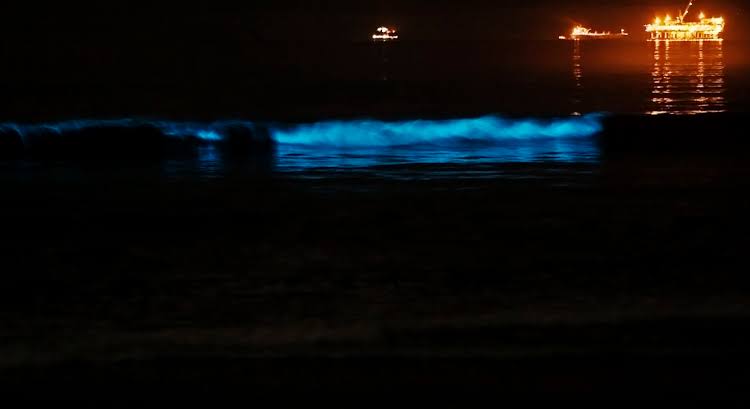Dinoflagellates are unicellular protists comprising two flagella. Dinoflagellates are mostly marine plankton, but also found in freshwater habitats. Photosynthetic dinoflagellates form one of the largest group of eukaryotic algae apart from diatoms.
Download Complete Chapter Notes of Biological Classification
Download Now
Dinoflagellates have characteristics of both plants and animals. There are more than 4500 species of dinoflagellates. Some are photosynthetic autotrophs and some species are heterotrophs, which get their nutrients by phagocytosis. They can be parasitic and endosymbiont to red algae.

Dinoflagellates Classification
Dinoflagellates were classified under kingdom Protista and phylum Dinoflagellata. Some scientists have kept dinoflagellates in the division Pyrrophycophyta (meaning- fire plants).
Dinoflagellates are kept in the supergroup Chromalveolata, they seem to have originated from the secondary symbiosis of red algae. The group Alveolata is characterised by the presence of similar ribosomal DNA sequence and alveoli, which is a flattened vesicle present inside the plasma membrane.
| Domain | Eukaryota |
| Kingdom | Protista |
| Supergroup | Chromalveolata |
| Group | Alveolata |
| Phylum | Dinoflagellata |
Dinoflagellates Characteristics

Dinoflagellates Structure
- Dinoflagellates are mostly marine but also found in freshwater. Their distribution is related to the temperature, pH and depth
- Dinoflagellates are unicellular having a eukaryotic cell
- They can be red, blue, green, yellow or brown depending on the pigment present in the cell
- The complex covering of their cell is called amphiesma, it has flattened vesicles
- Flattened vesicles known as alveoli are present inside the plasma membrane
- Alveoli of dinoflagellates contain cellulose plates, which are impregnated with silicates
- Dinoflagellates typically have two flagella. One of the flagella wraps around the transverse groove like a belt and the other flagellum projects behind the cell and present in the longitudinal groove, that is perpendicular to the transverse groove
- Dinoflagellates move like a spinning top with the help of flagella
- The cell of dinoflagellates has all common membrane-bound organelles such as mitochondria, Golgi bodies, rough and smooth endoplasmic reticulum and food vacuoles
- The nucleus of the dinoflagellates is called dinokaryon.
- Dinokaryon nucleus has chromosome attached to the nuclear membrane and condensed throughout. They lack histones and have a fibrillar appearance.
- The mitosis is closed type, i.e. the nuclear envelope does not break during mitosis. The mitotic spindle is extranuclear
- Rapid multiplication gives rise to sudden population explosions, or blooms, which is responsible for the red colour of the sea, the famous Red Tide. The toxins released by the blooms may kill fishes and reach humans, who eat those fishes
- Many dinoflagellates are bioluminescent and emit blue-green light
- Dinoflagellates also produce lipids and sterols. One of the sterols is known as dinosterol
Dinoflagellates Nutrition
- Dinoflagellates are mostly photosynthetic autotrophs.
- Heterotrophic dinoflagellates ingest other microorganisms and protozoans to get nutrients
- They are also present as endosymbionts in marine invertebrates such as corals, jellyfishes, etc.
- The photosynthetic endosymbionts are called Zooxanthellae, they provide carbohydrate to their hosts
- Endosymbiont dinoflagellates, which lack pigments are dependent on their hosts and live like a parasite
- Dinoflagellates are important producers in the marine ecosystem
- The chloroplast of dinoflagellates is bound by three membranes and originated from engulfing algae.
- It contains chlorophyll a, c and may contain various accessory pigments such as peridinin, fucoxanthin, etc.
- Some dinoflagellates are photosynthetic as well as heterotrophic, they are known as mixotrophic
Dinoflagellates Reproduction
- Reproduction in dinoflagellates is primarily asexual through binary fission. The cells are haploid.
- Sexual reproduction occurs by fusion to form a zygote. The zygote may form a resting stage known as dinocyst or may remain motile
- The zygote later undergoes meiosis to form haploid cells
- In unfavourable conditions, vegetative cells of dinoflagellates fuse together to form Planozygote. It takes in excess fat and oil, its shell becomes harder and size increases, the stage is known as Hypnozygote, that is very similar to the hibernating stage. Sometimes even spikes are formed
- Under favourable conditions, dinoflagellates break out the shell and present in a temporary stage known as Planomeiocyte. They quickly reorganise to their actual shape as a dinoflagellate.
Bioluminescent Dinoflagellates
Bioluminescence is the characteristic feature of dinoflagellates. More than 18 genera of dinoflagellates are bioluminescent.

Examples of the ecosystem having bioluminescent dinoflagellate are:
3 of the 5 bioluminescent bays are present in Puerto Rico, Montego Bay in Jamaica and Indian river Lagoon in Central Florida.
Blooms of dinoflagellates emit short flashes of light when disturbed mechanically by waves, ships or swimming. This appears as a bluish flicker in the ocean water at night.
Dinoflagellates use bioluminescence as a defence mechanism against their predators. Their predators become more vulnerable and in turn become prey of organisms of higher trophic levels.
Dinoflagellates Red Tide
Dinoflagellates sometimes multiply rapidly, resulting in population explosions or blooms. Bloom may contain more than a million cells per ml of water.

These blooms have known to create shellfish poisoning as they release a neurotoxin which kills the fishes. The colour of the sea appears red so it is known as “Red Tide”. This phenomenon is also referred to as “Harmful algal bloom (HAB)”. It may cause fatal or non-fatal illness in various other species eating contaminated fish including humans. After eating contaminated fishes, birds may die. Red tide has been found to cause the death of dolphins and manatees too.
All the blooms are not harmful.
The species of dinoflagellates causing red tide are:
Karenia brevis causing red tide in the Gulf of Mexico produces a neurotoxin called brevetoxin
Alexendrium fundyense is responsible for the red tide in the Gulf of Maine, produces a toxin named saxitoxin
Pfiesteria is a colourless dinoflagellate causing the toxic bloom
Dinoflagellates Examples
Some important genera of dinoflagellates are:
Noctiluca
Ceratium
Ornithocercus
Gonyaulax
Peridinium
Gymnodinium
This was all about Dinoflagellates. For more such topics related to NEET, visit BYJU’S.
Recommended Video:


It was useful 😊😊